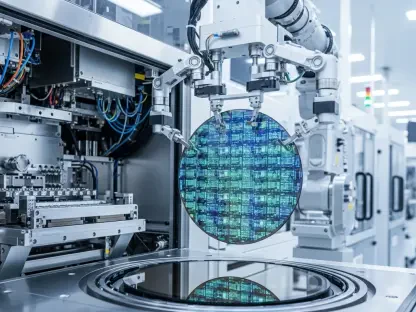Artificial Intelligence (AI) is set to dramatically transform the realm of computer vision, with forecasts indicating an extraordinary expansion from its current state to a $50 billion market by 2032. This striking growth path is propelled by a robust compound annual growth rate (CAGR) of 16.33%, signaling a decade where smart visual systems become deeply embedded in industries like automotive, healthcare, and beyond. As we progress through these years, these systems are anticipated to leverage the abilities of neural networks and deep learning technologies, not just to interpret visual data but to convert it into valuable insights for a wide array of applications. This remarkable growth trajectory reflects a time when intelligent visual systems become integrally woven into industries such as automotive, healthcare, and more. AI in computer vision promises to enhance efficiency and decision-making across sectors by offering new methodologies for data analysis, recognition, and predictive modeling. This shift opens doors to innovative solutions, potentially revolutionizing the way industries operate and interact with visual information, ushering in a new era of technological advancement.
Technological Integration and Investment
Expansion in Deep Learning and Edge AI
The integration of deep learning and edge AI in computer vision is making colossal strides, driven by significant investments from technology leaders such as NVIDIA and Google. These companies are spearheading advancements with hardware like GPUs tailored for real-time AI inference and comprehensive cloud vision services. As AI-powered systems become more sophisticated, they’re being seamlessly integrated into a range of industries. For example, in healthcare, AI aids in early diagnosis through advanced imaging techniques, while in the automotive sector, it’s pivotal in the development of autonomous driving technologies.
Such technological integration not only increases efficiency but also bolsters the accuracy and reliability of systems that rely on computer vision. The burgeoning interest and investment in this space signify a conscious effort to approach AI’s potential in a practical and scalable manner, ensuring that industries can leverage these technologies for strategic advancement. Moreover, as industries adapt AI capabilities, they unlock unprecedented opportunities for innovation, thereby fostering a competitive edge in an ever-evolving marketplace.
Practical Applications and Industry Adoption
Industries across the spectrum are witnessing a profound shift in operational dynamics thanks to AI-infused computer vision systems. In healthcare, AI is at the forefront of transforming diagnostics and patient care, enabling precision medicine through personalized treatment plans crafted with the assistance of AI-analyzed medical images. Similarly, in the automotive industry, AI is driving innovation, paving the way for smart vehicles equipped with enhanced safety features and autonomous capabilities.
Retail and security sectors are equally benefiting from AI’s prowess in computer vision, utilizing technologies like facial recognition and behavior analysis for improved customer experiences and heightened security measures. By analyzing consumer behavior, retailers can tailor experiences and optimize operations, while enhanced surveillance capabilities in security ensure proactive measures against potential threats. Investment and integration into real-world applications demonstrate AI’s potential to revolutionize process efficiency and product offerings, steering industries toward a future defined by capability and insight.
Market Growth and Projections
Expected Trajectory and Financials
The AI in Computer Vision Market, recently valued at USD 12.82 billion, is on an active incline, anticipated to surge to USD 14.91 billion next year and continue to an estimated USD 50.0 billion by 2032. This growth reflects not just the technological advancements but also the increasing adoption and trust in AI-powered visual systems across different sectors. The formidable CAGR of 16.33% sheds light on a promising trajectory, underscoring AI’s critical role in transforming traditional operations into intelligent systems driven by high-efficiency algorithms.
Several factors underpin this growth, including an escalation in AI applications within quality control processes in manufacturing and logistics. The heightened demand for autonomous solutions, like self-driving cars and drones, propels market expansion as industries quest for innovation and cost-effective solutions. The quest for futuristic and holistic solutions in various industries is a testament to AI’s growing influence and the sector’s impressive transition toward a tech-driven paradigm.
Expanding Horizons and Sectoral Influence
Amidst the evolving landscape, new avenues for AI applications continue to emerge, fueling market dynamics and offering lucrative opportunities for stakeholders. In healthcare, the integration of AI in medical diagnostics is expanding, with imaging technologies becoming more precise and scalable, thus improving patient outcomes. Surveillance and smart city initiatives are augmenting public safety and management through AI-driven systems capable of monitoring and processing vast amounts of visual data in real-time.
Retail transformations through cashier-less store technologies and personalized customer insights exemplify the growing adaptability of AI to consumer behaviors. Furthermore, its applications in agriculture focus on optimizing crop production through intelligent monitoring and environmental assessment. The cross-sector uptake denotes an era where AI becomes synonymous with competitive advantage and operational excellence, paving the way for a future-rich intelligent system ecosystem.
Market Opportunities and Challenges
Innovations and Adoption Catalysts
The market presents promising opportunities driven by rapid technological advancements and the pursuit of efficiency in processes across industries. As AI technology becomes more accessible, companies continue to invest in R&D to fashion pioneering solutions that address specific industry needs. In manufacturing, AI’s role in visual inspection for quality assurance proves indispensable, reducing errors and enhancing product consistency.
The automotive sector experiences a similar boon, where AI shapes the landscape of driverless vehicles, enhancing performance and safety. Drones and robotic applications, trusted with precision tasks, are evolving rapidly, showcasing AI’s versatility. These innovations, propelled by a blend of technical know-how and strategic investment, are laying robust foundations for notable market expansion and the enhancement of operational frameworks across various industries.
Navigating Privacy and Ethical Considerations
Despite extensive growth, the AI in Computer Vision Market faces significant challenges regarding data privacy and ethical concerns, particularly in facial recognition applications. Scrutiny surrounds the use of AI technologies for surveillance, demanding stringent regulations and transparent practices that protect privacy. The controversy with prominent companies, including Chinese firms like Hikvision, underscores the need for balanced advancement, with a focus on ethical AI deployments that respect privacy while achieving technological progress.
Navigating these challenges requires collaborative efforts among policymakers, industry experts, and technology developers to establish frameworks that uphold security and privacy. As the AI landscape evolves, addressing these issues is imperative for fostering user trust and ensuring ethically sound technological evolution. Solutions focused on reinforcing data protection and ethical transparency are pivotal in ensuring AI’s long-term viability and acceptance.
Main Findings and Narrative
Dynamic Landscape and Strategic Importance
The AI in Computer Vision Market illustrates not just a story of technological advancement but a strategic transformation defining how industries operate and compete. The convergence of AI with other emerging technologies like 5G and edge computing heralds a new era of real-time, efficient data processing, elevating computer vision’s capabilities. The far-reaching potential of this technology lies in its ability to confer operational advantages to businesses, initiating widespread adoption in sectors ranging from healthcare to industrial security.
However, amid these advancements, it’s critical to address stakeholder concerns surrounding regulation, privacy, and ethical deployment to ensure sustainable growth. By leveraging AI technologies strategically, businesses can unlock new dimensions of productivity and innovation, positioning themselves advantageously in a rapidly evolving marketplace.
Ensuring a Seamless Transition to the Future
Ensuring a seamless transition to the future involves addressing challenges and embracing AI’s transformative impact on computer vision. By focusing on ethical, strategic, and innovative approaches to AI integration, stakeholders can foster a future rich with intelligent systems, meeting both industry needs and societal expectations.









